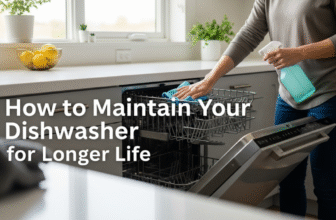
With daily care, a clean coffee grinder is capable of making the morning brew significantly better. What few coffee connoisseurs know is that the grinder is secretly undermining them. Old residues, stale material, and stuck build-up turn fine beans into a bitter let-down.
Even among those paying dollars for higher-end, special-bean coffee, the delicacy required to keep their grinder clean is overlooked. This omission causes the less-than-satisfying situation of serving low-quality coffee from top-of-line-grade materials
But the good news is grinder maintenance really only takes a few minutes a week. Clean grinders lead to fresh and delicious coffee, healthier coffee, and long-lasting grinders. This complete guide uncovers all the pro cleaning tips that will redefine your daily coffee ritual.
The Importance of Cleaning Coffee Grinder
The oils in the coffee contribute to both the rich taste and aroma. Unfortunately, these very oils are the bane of your grinder. Grinding generates heat which oxidizes and sticks the oils to metal surfaces.
Rancid oils taste bitter and rancid. They inundate subtle coffee flavours and make for an unwelcome aftertaste. Even single-origin beans will fall flat when ground in dirty equipment.
Also, the old coffee particles retain moisture and grow mould. Bacteria love warm, moist grinding chambers. No one wants their morning cup to be contaminated with coffee like that.
Clean grinders will correct these problems immediately. And who doesn’t want pure coffee flavours? Uniform particle size enhances extraction and results in a more consistent, flavourful cup.
Things You Probably Already Have to Clean Your Coffee Grinder With
The most effective cleaning supplies are likely sitting in your kitchen at this very moment. You don’t need expensive specialty products to achieve a professional finish.
Basic cleaning kit:
- Soft-bristled toothbrush
- Clean microfiber cloths
- Wooden toothpicks
- Mild dish soap
- White vinegar
- Uncooked rice
Optional tools:
- Small vacuum or compressed air
- Grinder cleaning tablets
- Food-safe lubricant
Store them together near your coffee setup. Easy access makes for no-effort maintenance. Maintenance is a breeze with easy access.
Blade Grinder Cleaning Made Simple
Blade grinders chop beans with a spinning metal blade. They’re not complicated, by any means, but cleaning them is as simple as it gets and people just don’t.
Daily Blade Grinder Maintenance
First of all, you need to unplug your grinder. Never try to use with electricity. Empty any remaining beans from the grinding chamber.
Brush away any loose debris on the blades and chamber walls with a dry brush. Make sure to check all the corners where grounds like to lurk. Clean the outside of the grinder with a damp rag.
Weekly Deep Clean of Blade Grinders
Take out the grinding chamber, if your grinder is compatible. Wash any removable parts with warm soapy water. Care should be taken to rinse well and to make sure all parts are dry before re-assembling.
For non-dishwasher safe chambers, soak interior with a wet rag. Do not let water touch any electrical parts. Clean out the small spots with toothpicks.
How to Clean a Burr Grinder
Burr grinders achieve their grind through two abrasive surfaces rubbing against each other. This precision grinding necessitates more thorough cleaning than blade models.
Accessing Burr Components
On the majority of burr grinders you can take off the top burr. Refer to your manual for exact directions. In general, you lift or twist off the upper burr to extract it.
Be gentle with the burrs – they are precision-machined parts. Laying on clean surfaces will aid in the prevention of damage.
Cleaning Burr Surfaces Properly
Brush both burr sides with a stiff brush. The secret is to work in a circular pattern, following the burr grooves. Rinse away any visible coffee residue and oils.
For build-up that refuses to budge, try using a toothpick to scrape grooves gently. Also, never use metal tools that could scratch the sensitive surfaces.
Chamber and Chute Maintenance
Use compressed air or a small vacuum to clean debris from the grinding cavity. Concentrate on the lower burr and exit chute areas.
Dry all surfaces that can be reached with a microfiber towel. Keep moisture away from electrical parts and motor housing.
How to Clean Your Coffee Grinder Equipment: A Step-by-Step Guide
Step 1: Preparation and Safety
But first, turn off and unplug your grinder. Wait until all moving parts have come to a complete stop. Empty hopper and grinding chamber of beans.
Photograph your grinder, disassembled. This is useful during reassembly, in particular for more complicated burr types.
Step 2: Disassemble Removable Parts
Remove the bean hopper first. And then, remove the upper burr if it is there. Finally, take out the ground chamber.
Go slow and don’t force anything. If something feels a bit stuck, refer to the manual before you push too hard.
Step 3: Brush Off the Coffee Particles
Begin with a dry brush to brush away loose grounds. Do from the top down, letting gravity pull it down and out.
Thoroughly clean corners, grooves and sinks where dirt collects. For narrow spots brushes can’t reach, toothpicks work well.
Step 4: Wash Removable Components
Wash the removable components with soapy, warm water. Scrub away stubborn residue using a soft brush. Rinse thoroughly with clean water.
Make sure all parts are dry before reassembly. Even minute quantities of moisture are problematic.
Step 5: Clean Interior Surfaces
Use a microfiber cloth moistened with water to wipe the interior surfaces. For more stubborn stains, apply a solution of water and mild dish soap.
Never spray water over or into your grinder. No, instead wet your cloth and wring out the excess.
Step 6: Complete Drying Process
Let all parts air dry for a minimum of 30 minutes. Put them in a cool, dry place, not in direct sunlight.
Moisture is your grinder’s enemy. Rushing things along can damage equipment with electrical issues or some sort of bacterial growth.
Step 7: Careful Reassembly
Reassemble components in reverse order. Check to make sure all of the pieces fit evenly and can be easily removed and added without being forced.
Give your grinder a test run before adding the beans. Listen for irregular sounds that can denote bad assembly.
Natural Ways to Clean That Really Do Work
Rice Cleaning Method Explained
You can also use dry rice as an all-natural grinder cleaner. Tough rice grains work to clean oils and impurities as they’re pulverized into powder.
Add 1/4 of a cup of dry white uncooked rice to your clean grinder. Grind until rice is fine powder, about 30 to 60 seconds.
Empty rice powder completely. Remove any dust, if there is still any left, with a dry cloth. Rice soaks up oils in the coffee while scrubbing the surfaces clean.
A word of caution: Rice cleaning should only be used on blade grinders a few times—and never used to clean burr grinders. The hardness can also wear out blades over time.
Cleaning Tablet Benefits
Commercial grinder cleaning tablets can clean your burr grinder more quickly than rice. These compressed tablets are specially designed for use with coffee equipment.
Follow manufacturer instructions exactly. Just about all the tablets need to be ground, just like regular coffee beans. The powder cleans as it passes through your system.
After I use cleaning tablets, I always run a small batch of real coffee beans. This eliminates any residue of cleaning in time for your next cup.
Common Cleaning Mistakes to Avoid
Water Damage Prevention
Never aim a jet of water at electrical parts. Short circuits can occur, as well as permanent motor damage.
Keep all detachable parts away from water only use with water. For fixed elements, apply damp cloths, wringing them out before applying.
Chemical Contamination Issues
Do not use harsh chemicals such as bleach or ammonia. This can carry over to future coffee while also harming plastic parts.
Keep regular cleaning of mild dish soap. Natural approaches such as rice cleaning are less harmful.
Mechanical Damage Prevention
Don’t force stuck components apart. Too much pressure can break plastic parts or strip the screw threads.
If something seems stuck, consult your manual or customer service. Professional repair is cheaper than replacement.
Creating Your Maintenance Schedule
| Frequency | Tasks |
|---|---|
| Daily | Empty hopper, brush particles, wipe exterior (30 seconds) |
| Weekly | Remove parts, wash components, deep clean chamber (10 minutes) |
| Monthly | Rice cleaning or tablets, inspect for wear (20 minutes) |
| Quarterly | Complete disassembly, check calibration (30 minutes) |
Daily Quick Clean (30 seconds)
Dump out any remaining beans from the hopper. Whisk away excess with a dry brush. Wipe outside surfaces with a dry cloth.
These simple procedures will do a lot to avoid problems with buildup. What is important for daily maintenance is persistence, not intensity.
Weekly Deep Clean (10 minutes)
Disassemble and clean all detachable parts. Clean the grinding chamber thoroughly. Remove burrs or blades with visible wear.
Regular cleaning once every week will ensure the peak performance of your grinder, keeping it free from any oil residue.
Monthly Intensive Maintenance (20 minutes)
Do a rice wash or use the cleaning tablets. Check components for any damage or excessive wear. If recommended by the manufacturer, lubricate moving parts.
Those are things that monthly maintenance can catch before those become costly repairs.
Quarterly Professional-Level Service (30 minutes)
Take your grinder apart and clean them thoroughly. Check if grind consistency looks good. If you need to adjust the grind feel free. Replace any worn parts, such as seals or gaskets.
Regular maintenance keeps your grinder in pristine condition for years.
Troubleshooting Tips: When Coffee Grinder Maintenance Just Isn’t Enough
Inconsistent Particle Sizes
Symptoms: Inconsistent grind despite settings
Likely causes: Dull/damaged burrs, worn parts
Solution: Deep clean first, then visually examine burrs for damage
If cleaning does not resolve the issue, burrs may have to be replaced. The majority of home grinders should have their burrs replaced after 500-1,000 pounds of coffee being ground.

How to Clean a Coffee Grinder Properly
Bitter or Stale Coffee Taste
Symptoms: Off-flavour in fresh beans
Probable causes: Rancid oil build-up or old particle contamination
Solution: Cleaning tablets or rice method
Repeat taste problems suggest serious contamination. Professional servicing for expensive grinders might be worth it.
Unusual Operating Noises
Symptoms: Squealing, grinding, or rattling
Most likely causes: Foreign object inside, worn bearings, or loose part
Solutions: Stop using immediately and check for debris
An unusual noise is often a sign of mechanical trouble. Do not neglect early-warning signs that can help prevent serious damage.
Grinder Won’t Turn On or Runs Slowly
Symptoms: Motor fault or impaired operation
Likely cause: Electrical or mechanical binding
Solution: Investigate for blockages first; refer to manufacturer if needed
Motor issues usually need to be repaired by a professional. Don’t attempt electrical work yourself.
Extending Your Grinder’s Lifespan
Bean Quality Matters
Whenever possible, use fresh, correctly roasted beans. Stale or too-dark beans produce more oils and residue. They are also harder to grind, which puts increased wear on equipment.
Keep beans in airtight containers and store them in a cool, dark place. The right storage will keep oils from turning rancid before grinding becomes possible.
Capacity Management
Do not pack your grinder beyond what is recommended by the manufacturer. Overloading the grinding chamber also causes the motor to work harder and the grinding wheels to act differently.
Only process beans in smaller amounts as this will provide more even bean consistency and not put so much strain on the motor.
Regular Calibration Checks
Test your grinder’s particle size consistency every month. Make a few test cups with varying settings to make sure everything is calibrated correctly.
Consistent particle sizes are proof of a well-functioning grinder. Sudden shifts indicate that your grinder is either wearing out inside or getting damaged.
UK Considerations for Coffee Grinder Care
Hard Water Challenges
Water in the UK is also very hard. These minerals can accumulate in grinders, particularly in steam components.
If your area has very hard water use filtered water to wash. This also prevents minerals from building up and affecting your performance.
Humidity Effects
The UK climate poses a humidity challenge for coffee machinery. The more moisture, the more important thorough drying is.
Try placing packets of silica gel in the storage room and in drawers to soak up humidity. This will help prevent mold and electrical issues.
Local Supply Sources
Specialist cleaning products are sold by many UK coffee merchants. Search for grinder cleaning tablets at stores like:
- Pact Coffee (online and stores)
- Has-bean Coffee
- Local specialty roasters
- Amazon UK for wider selection
Local retailers often have better customer service and product knowledge support.
When It’s Time to Get Professional Help with Your Grinder
Annual Professional Cleaning
You can still get them professionally serviced once a year for expensive burr grinders. Techs can adjust settings, replace worn components, and clean/perform maintenance above and beyond typical home cleaning.
Professional servicing costs £30-50 but can give the grinder a few more years of life.
Warranty Considerations
Find out if DIY cleaning impacts your warranty. Certain manufacturers recommend professional service in order to ensure safety and proper performance.
Save receipts for cleaners and record when you have maintained your equipment. This is good documentation for proper care when warranty support issues are revealed.
Cost-Benefit Analysis
Compare the cost of professional cleaning with replacement cost. Annual professional service is financially justified for grinders valued at £200 or more.
Entry level models may not offer the value for investment in a professional’s time. You can replace them when cleaning is no longer effective to keep performance.
Advanced Techniques for Coffee Enthusiasts
Ultrasonic Cleaning Methods
Some hardcore coffee enthusiasts use ultrasonic cleaners for removable burr parts. These mechanisms blast away tiny particles with sound waves.
Safety warning: Only ultrasonic clean parts directly approved by your manufacturer. Check any warranty implications prior to utilizing this method.
Professional-Grade Degreasers
Commercial coffee equipment cleaners contain food-safe degreasers that are highly effective. These are products that take care of oil build-up that home methods find hard to handle.
Be sure to always rinse well after working with commercial degreasers. However, reassemble only when dry to avoid contaminating the device.
Steam Cleaning Applications
Commercial steam cleaners can sterilize your grinder with no chemicals involved. Careful execution is required for this technique not to damage from moisture.
Only use steam cleaning on completely removable components. Never use steam against electrical parts or inside the housing.
Frequently Asked Questions
How frequently should I clean my coffee grinder?
Empty beans and brush out the grinder daily. Clean weekly with soap and water. Monthly cleaning tablets or rice technique works best.
Can I clean my grinder parts in the dishwasher?
Check your manual first. Some removable parts can go into the dishwasher, but some are likely to warp or discolor. Washing by hand means you have more control over the cleaning process.
How can you get rid of those pesky coffee oils?
Grinder cleaning tablets are most effective for removing coffee oils. They’re tailored to be effective at dissolving these residues without harming equipment.
When does my grinder require professional service?
Keep an eye out for irregular grinding sounds, strange noises, and lingering taste issues (even after you thoroughly clean your grinder). These signs can signal internal breakdown and should be examined by a professional.
Is cleaning grinder with rice safe for all grinders?
Rice cleaning is effective for blade grinders, but can cause dulling in blade grinder parts. Do not do this with burr grinders too often.
Is my grinder retaining too much coffee?
All grinders retain some ground coffee between uses. Keep retention low by running a few beans before grinding the amount you want. This purges old particles.
How long should machine components dry after washing?
Air-dry for a minimum of 30 minutes in a well-ventilated space. Rushing through the drying step can cause moisture issues and bacterial growth.
Can I clean my grinder with regular dish soap?
You can use gentle dishwashing soap to clean removable parts. Stay away from antibacterial soaps or harsh detergents which will leave lingering residues.
Take Your Coffee to the Next Level Today
Learning how to clean coffee grinder equipment will change your coffee life forever! Freshly cleaned grinders expose flavours you never knew were hiding in your favourite beans. The contrast between dirty and clean equipment is striking and will be immediately apparent.
Preventative maintenance will help keep costly repairs at bay and extend the life of your equipment. Your high-quality coffee beans deserve just as clean of a grinder to show off their individual flavours.
Best of all, a clean grinder yields a consistent product. Each and every cup surpasses your expectations when you have the best equipment to work with. Never again be disappointed in your morning grind.
Begin with these cleaning methods now. For more helpful tips on maintaining your kitchen appliances and coffee equipment, visit https://smartlivingdealz.com/. And tomorrow morning, your grinder and your taste buds will thank you. The journey to the perfect cup of coffee starts with clean equipment.






